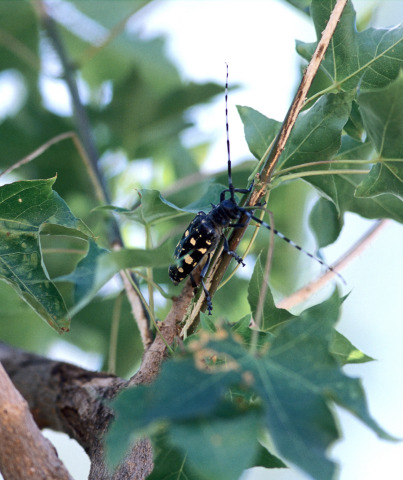WASHINGTON--(BUSINESS WIRE)--August is the peak time of year to spot the Asian longhorned beetle (ALB) as adults emerge from trees. That’s why the U.S. Department of Agriculture (USDA) is declaring August as “Tree Check Month.” Checking trees for the beetle and the damage it causes is one way residents can protect their own trees and help USDA’s efforts to eliminate this beetle from the United States.
“Just this past June, we confirmed a new infestation in South Carolina after a homeowner reported that they found a dead Asian longhorned beetle on their property,” said Josie Ryan, APHIS’ National Operations Manager for the ALB Eradication Program. “We need the public’s help to find new areas where the beetle has spread, because finding it sooner means less trees will become infested.”
ALB is an invasive wood-boring beetle that attacks 12 types of hardwood trees in North America, such as maples, elms, horse chestnuts, birches and willows. In its larval stage, the insect feeds inside tree trunks and branches during the colder months. The beetle creates tunnels as it feeds, then chews its way out as an adult in the warmer months. Infested trees do not recover and eventually die. Infested trees can become safety hazards since branches can drop and trees can fall over, especially during storms.
The beetle has distinctive markings that are easy to recognize:
- Black and white antennae that are longer than the insect’s body.
- A shiny black body with white spots that is about 1” to 1 ½” long.
- Six legs and feet that can appear bluish-colored.
Signs that a tree might be infested include:
- Round exit holes in tree trunks and branches about the size of a dime or smaller.
- Shallow oval or round scars in the bark where the adult beetle chewed an egg site.
- Sawdust-like material called frass, laying on the ground around the tree or in the branches.
- Dead branches or limbs falling from an otherwise healthy-looking tree.
ALB is not harmful to people or pets. If possible, residents should take pictures and capture suspicious insects in a durable container and freeze them, which helps preserve the insect for identification. Residents can report the insect or tree damage by calling the ALB hotline at 1-866-702-9938 or reporting online at www.AsianLonghornedBeetle.com.
“As people use firewood this summer, we are also asking them to buy heat-treated and certified wood rather than move untreated firewood long distances, which can potentially spread ALB,” warned Ryan. “You can also responsibly gather firewood where you will burn it or buy it in the area where you will use it.”
Firewood cannot move out of areas that are quarantined for ALB without a permit. It is important that people follow state and federal laws, which restrict the movement of woody material, to keep the tree-killing pest from spreading outside of known infested areas.
It is possible to eradicate the pest. Most recently, USDA and its partners declared Brooklyn and Queens in New York free of ALB. The insect has also been eradicated from areas in Illinois, New Jersey, Boston, Massachusetts, other portions of New York, and portions of Ohio.
For more information about the Asian longhorned beetle, other ways to keep it from spreading and eradication program activities, visit www.AsianLonghornedBeetle.com. For local inquiries or to speak to your State Plant Health Director, call 1-866-702-9938.
The United Nations General Assembly has declared 2020 the International Year of Plant Health (IYPH). Please join USDA APHIS to help protect the world’s crops, forests, gardens and landscapes against invasive pests. Learn more by visiting www.aphis.usda.gov/planthealth/2020.
USDA is an equal opportunity provider, employer and lender.




